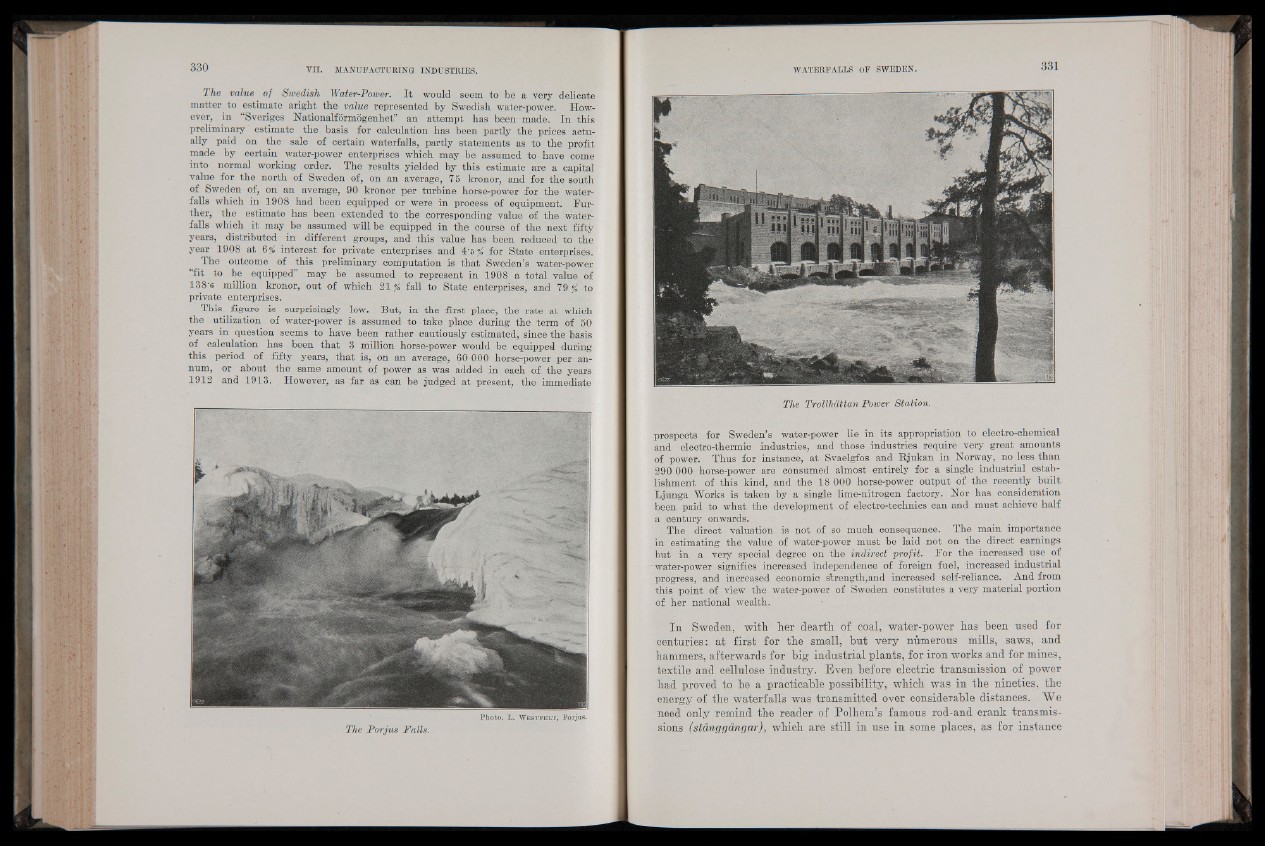
The value of Swedish Water-Power. It would seem to be a very delicate
matter to estimate aright the value represented by Swedish water-power. However,
in “Sveriges Nationalformogenhet” an attempt has been made. In this
preliminary estimate the basis for calculation has been partly the prices actually
paid on the sale of certain waterfalls, partly statements as to the profit
made by certain water-power enterprises which may be assumed to have come
into normal working order. The results yielded by this estimate are a capital
value for the north of Sweden of, on an average, 75 kronor, and for the south
of Sweden of, on an average, 90 kronor per turbine horse-power for the waterfalls
which in 1908 had been equipped or were in process of equipment. Further,
the estimate has been extended to the corresponding value of the water7
falls which it may be assumed will be equipped in the course of the next fifty
years, distributed in different groups, and this value has been reduced to the
year 1908 at Q% interest for private enterprises and 4'e % for State enterprises.
The outcome of this preliminary computation is that Sweden’s water-power
“fit to be equipped” may be assumed to represent in 1908 a total value, of
138‘6 million kronor, out of which 21 % fall to State enterprises, and 7 9 ^ to
private enterprises.
This figure is surprisingly low. But, in the first place, the rate at which
the utilization of water-power is assumed to take place during the term of 50
years in question seems to have been rather cautiously estimated, since the basis
of calculation has been that 3 million horse-power would be equipped during
this period of fifty years, that is, on an average, 60 000 horse-power per: annum,
or about the same amount of power as was added in each of the years
1912 and 1913. However, as far as can be judged at present, the immediate
The Porjus Falls.
P h o to . L . We s t f e l t , P o rju s .
The Trollhättan Power Station.
prospects for Sweden’s water-power lie in its appropriation to electro-chemical
and electro-thermic industries, and those industries require very great amounts
of power. Thus for instance, at Svaelgfos and Bjukan in Norway, no less than
290 000 horse-power are consumed almost entirely for a single industrial establishment
of this kind, and the 18 000 horse-power output of the recently built
Ljunga Works is taken by a single lime-nitrogen factory. Nor has consideration
been paid to what the development of electro-technics can and must achieve half
a century onwards.
The direct valuation is not of so much consequence. The main importance
in estimating the value of water-power must be laid not on the direct earnings
but in a very special degree on the indirect profit. For the increased use of
water-power signifies increased independence of foreign fuel, increased industrial
progress, and increased economic strength,and increased self-reliance. And from
this point of view the water-power of Sweden constitutes a very material portion
of her national wealth.
In Sweden, with her dearth of coal, water-power has been used for
centuries: at first for the small, but very numerous mills, saws, and
hammers, afterwards for big industrial plants, for iron works and for mines,
textile and cellulose industry. Even before electric transmission of power
had proved to be a practicable possibility, which was in the nineties, the
energy of the waterfalls was transmitted over considerable distances. We
need only remind the reader of Polhem’s famous rod-and crank transmissions
(stanggangar), which are still in use in some places, as for instance